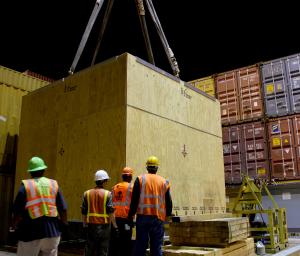US ships 14,000 kilos of magnet hardware to Europe
12 Jun 2014
-
Lynne Degitz, US ITER
The 800-metre sample toroidal field conductor was transferred to a container ship at the port of Charleston, South Carolina, on 28 May for its voyage to the European winding facility in La Spezia, Italy. Photo: US ITER
One of the unique and unusual aspects of participating in the ITER Project is the long and often intricate journey that hardware components must make from their manufacturing and testing sites to Saint Paul-lez-Durance, France where ITER is under construction.
The logistics and coordination can be daunting, but the ITER Members are well prepared to face the challenge. The US Domestic Agency US ITER worked closely with vendor High Performance Magnetics in Tallahassee, Florida, to complete fabrication and transfer 800 metres of sample toroidal field magnet conductor to the port in Charleston, South Carolina, from where it will be shipped to the European winding facility in La Spezia, Italy. Delivery is expected to occur in late June.
The shipping procedures are exacting to ensure the safe delivery of the sample conductor, which weighs about 14,000 kilos—shipping crate included.
"The coil of sample conductor is about four metres in diameter. It is stacked up like a Slinky and can actually move like a Slinky if we don't secure it," said Kevin Chan, a project engineer for the US ITER magnet systems.
The sample conductor, composed of non-superconducting copper strands, was produced in order to qualify the conductor fabrication processes; the production conductor installed in the ITER Tokamak will be composed of a mixture of copper and niobium-tin superconducting strands.
The lift fixture, which is integral to the crate around the conductor, helps the conductor maintain its shape within the ITER requirement of +/-6 millimetres. The US ITER team actually achieved an even tighter tolerance of +/-1.5 millimetres with the fixture design. The fixture also had to meet European standards for rigging and is CE marked to indicate that requirements were met.
"Securing the conductor with the fixture is necessary for the safety of the conductor and of the people handling it, plus for stability and integrity of the conductor," Chan said.
The shipping crate can be delivered by container ship; however, securing the cube-shaped crate to the vessel required some additional attention to address its specific design features. Not all ports have the specialized equipment and rigging needed to handle oversized cargo.
"There are a lot of unique aspects to ITER shipments, including international collaboration, dealing with a variety of shipping origins and destinations, different vessel types and selecting the best method for transportation with attention to costs, timing and risk," said Jeff Parrott, logistics and transportation coordinator at US ITER.


